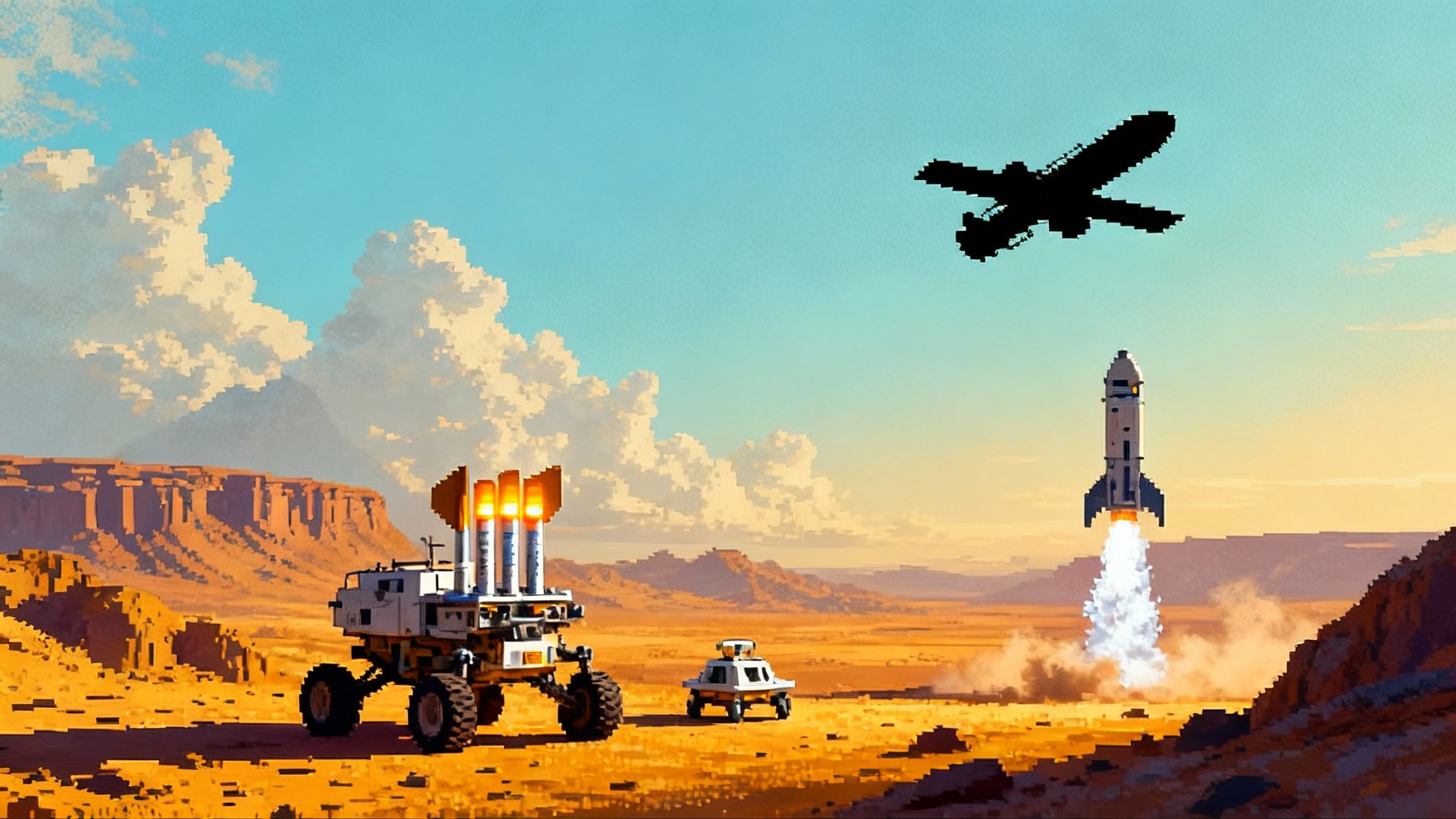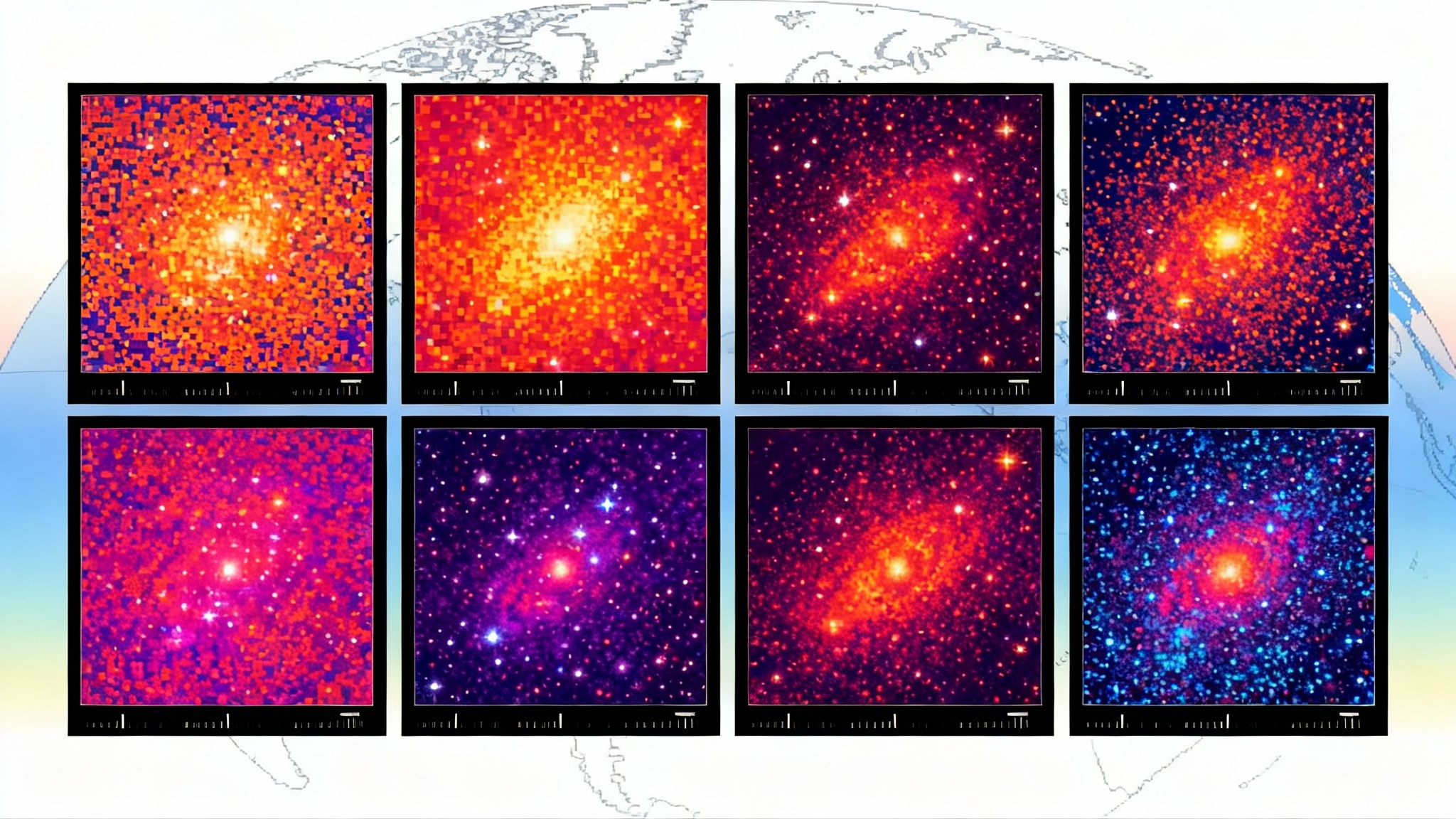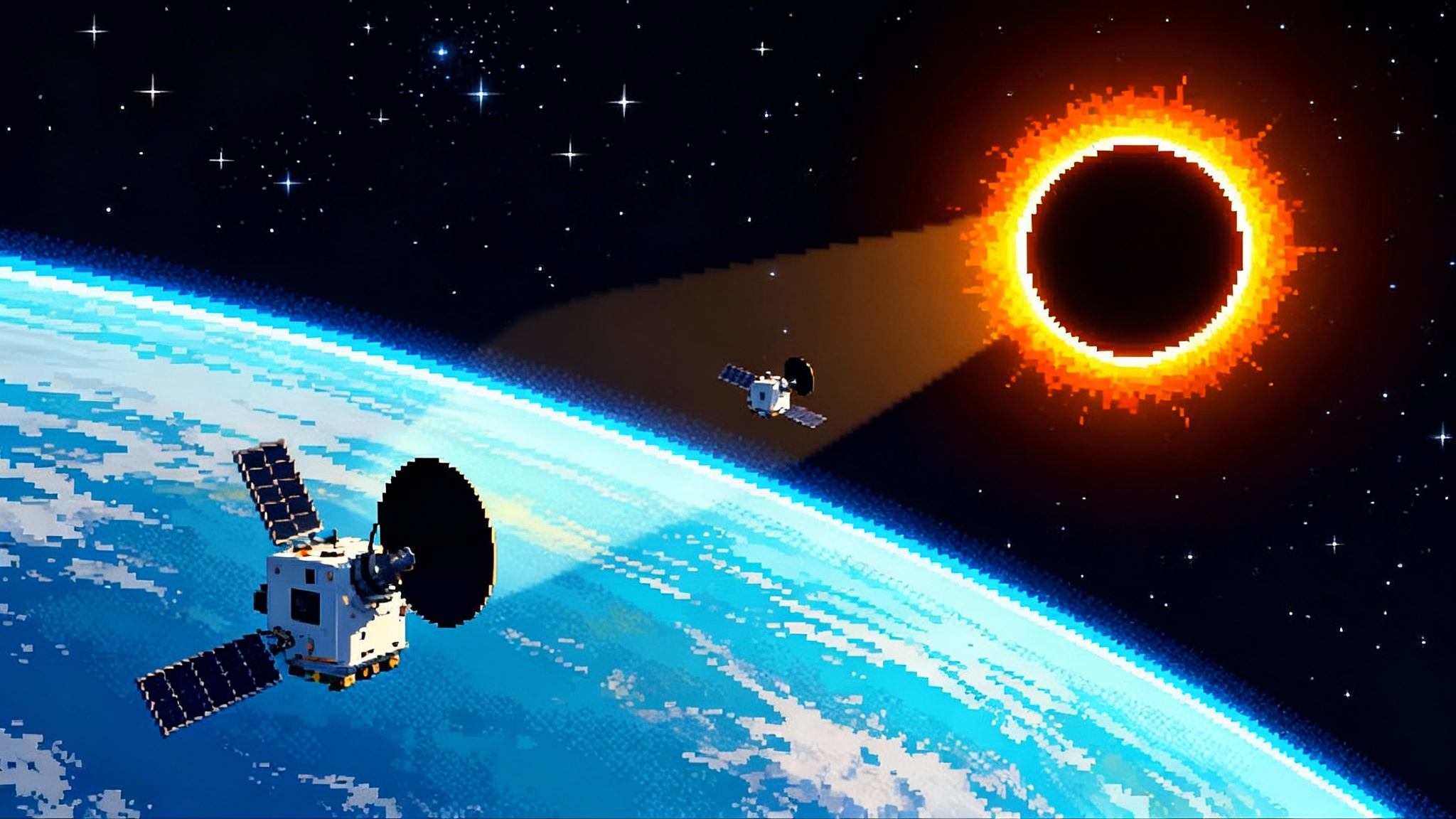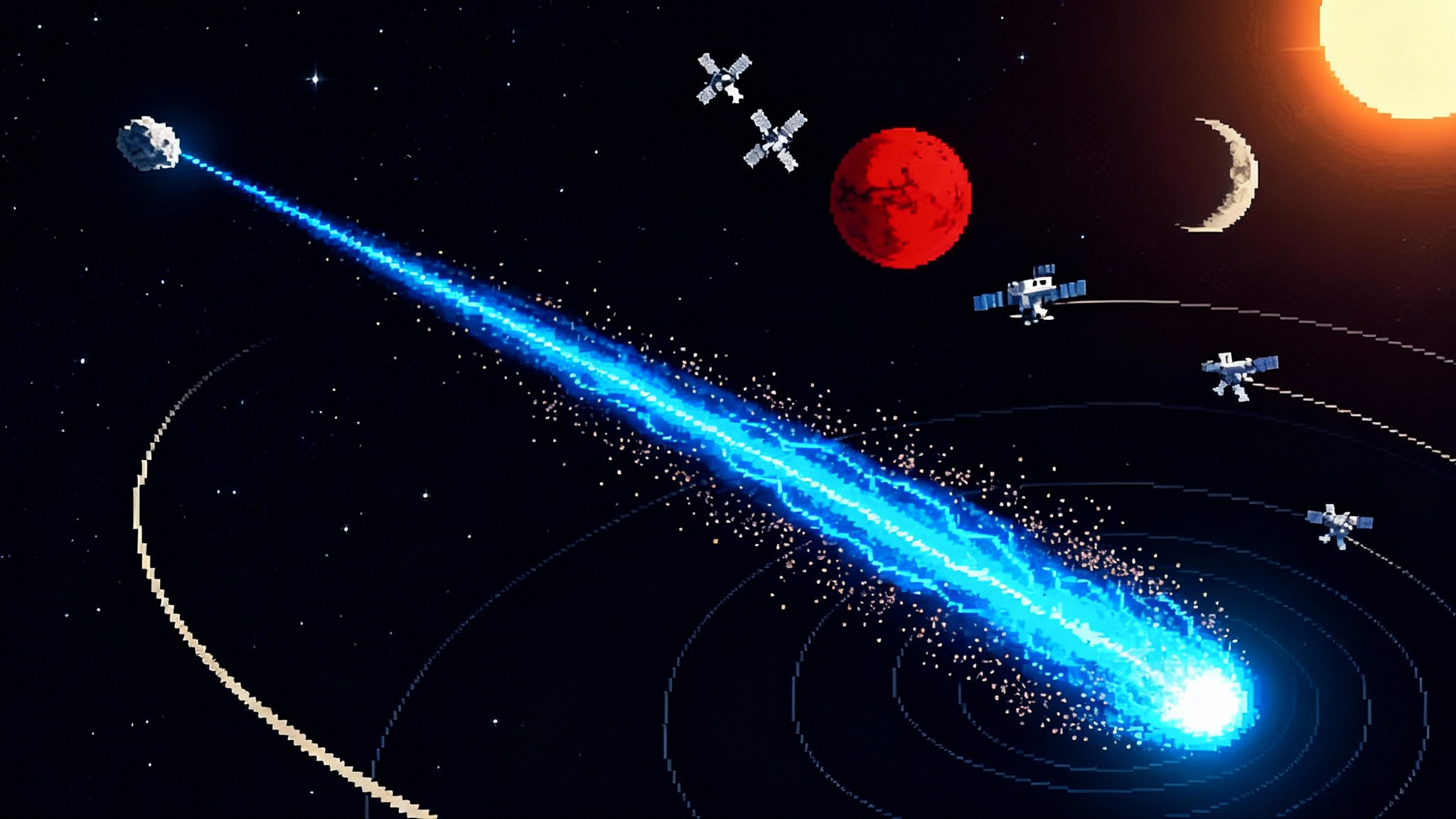Tianwen-2 Begins the Quasi-Moon Sample-Return Era
Launched in late May 2025, Tianwen-2 is racing toward Earth’s quasi-moon Kamoʻoalewa for a fast-turn sample return by late 2027, then pressing on to active asteroid 311P. Here is why this two-target, solar-electric mission could reset small-body science and planetary defense.

Breaking news that resets the small-body playbook
At the end of May 2025, China lit the fuse on a new kind of deep-space campaign. The Tianwen-2 spacecraft departed from Xichang atop a Long March 3B, headed first for Earth’s quasi-moon Kamoʻoalewa and then for the active comet 311P/PANSTARRS. It is an audacious plan with a near-term payoff. If all goes to schedule, Tianwen-2 will rendezvous with Kamoʻoalewa in mid 2026, collect at least a handful of material, and deliver that sample to Earth by late 2027. The mothership will then continue outbound to a second target rather than retire. For planetary scientists and planetary defenders, this is not just another asteroid visit. It is the start of a quasi-moon sample-return era that compresses timelines and multiplies targets. The program’s scope is visible in early briefings and agency statements, including a Chinese Academy of Sciences overview that details sampling at Kamoʻoalewa, a later rendezvous with 311P, and a late 2027 Earth delivery window.
What is a quasi-moon, and why Kamoʻoalewa matters
A quasi-moon is not a true satellite. Think of it as a runner on a nearby track lane that happens to keep pace with Earth for many laps. Kamoʻoalewa, also cataloged as 469219 and discovered in 2016, traces an orbit around the Sun that resonates with ours so closely that for years it appears to loiter near our planet. That proximity makes it a low energy target and a high information prize.
Kamoʻoalewa is small, roughly the size of a sports arena, and it spins fast. Telescopic studies found a rotation period near half an hour and a reflectance spectrum that looks more like weathered lunar material than a typical inner solar system asteroid. That peculiar match has kept a bold hypothesis alive: Kamoʻoalewa could be a fragment blasted off the Moon long ago, later nudged by sunlight and gravity into its current Earth-trailing dance. A widely cited lunar-like silicates analysis lays out the case based on multi-telescope observations.
If Tianwen-2 brings back even tens of grams of regolith from an object that formed as lunar ejecta, the implications are immediate. We would hold a piece of the Moon’s violent past that never touched Earth’s atmosphere, preserving delicate clues to impact mechanics and space weathering that meteorites often erase on entry.
Why 2026–2027 is an inflection point
Many missions promise breakthroughs in the far future. Tianwen-2 is built to deliver two surges of new knowledge on a short fuse.
- Approach and mapping in 2026. During proximity operations, the probe will measure size, mass, shape, rotation, and surface texture with cameras, thermal spectrometers, and radar. These data tighten models of how small bodies hold together and shed material.
- Sampling and Earth delivery by late 2027. Returning a curated sample from such a small, fast-rotating, likely space-weathered body will anchor lab results to a known geological context. That is the bridge scientists need to connect telescope spectra to actual rocks and dust.
For planetary defense, two concrete payoffs arrive quickly:
- Material properties now, not hypotheticals later. Engineers need values such as grain size distribution, porosity, cohesion, and thermal inertia to model deflection outcomes. Tianwen-2’s surface contact and sampling will directly inform those knobs.
- Dynamics of a fast spinner. Small bodies that rotate in tens of minutes are common. If Kamoʻoalewa is cohesive enough to stay intact under rapid spin, then kinetic impact predictions need to include that strength. If it is rubble with a thin crust, that points to a different response to a push.
In other words, Tianwen-2 takes us from guessing with analogs to calculating with measurements during the same period when defense programs are building the next generation of tests.
The multi-target, solar-electric template
Tianwen-2 is designed around continuous low-thrust propulsion and task sequencing that keeps the prime spacecraft working after it drops the sample capsule. The pattern looks like this:
- Use chemical propulsion to punch out of Earth’s gravity and set up an efficient cruise.
- Switch to solar electric propulsion for months-long, gentle thrusting that trades propellant mass for patience.
- Conduct close operations and sampling at a near-Earth target where rendezvous is relatively affordable.
- Return to Earth’s vicinity, release a compact sample courier on a precise reentry corridor, and execute a gravity assist.
- Reuse the flight-proven mothership for a second deep-space objective with the same sensors and thrusters.
This is the playbook the Dawn mission pioneered at Vesta and Ceres, updated for sample-return logistics and extended operations. For additional context on how small-body operations are evolving ahead of 2029, see Apophis 2029 and OSIRIS-APEX.
The economic logic is compelling. A single spacecraft bus, flown once, can support two very different science cases and amortize nonrecurring engineering across both. For nations or agencies trying to stretch budgets, the message is simple. If you can keep the solar arrays healthy and the thrusters firing, a small-body campaign can become a multi-target tour without a second launch.
Two sampling styles, one goal
Tianwen-2 is expected to try two different ways to capture material. Touch-and-go sampling scrapes and ingests surface grains during a brief contact, a method validated by NASA’s OSIRIS-REx and Japan’s Hayabusa2. Anchor-and-attach sampling adds a more ambitious step. The lander portion deploys multiple arms to grip and drill, seeking to gather material that is not simply loose dust. If the second method works, it will deliver a complementary physical record: texture, compaction, and cohesion a few centimeters below the weathered skin. If it struggles, that will be equally valuable. A bounce, a sink, or a brittle fracture are all data about a surface we might one day need to push.
Planetary defense: from headline tests to material science
Space agencies have already tested deflection physics at full scale, most notably with a kinetic impactor on a near-Earth asteroid in 2022, followed by a reconnaissance mission to map the aftermath. Those campaigns proved that a shove can move a small body measurably. What they did not provide is a library of material behaviors across many small-body types. Tianwen-2 helps fill that shelf.
Here is what matters for defense, in the exact sequence engineers use when sizing a deflection mission:
- Density and porosity inform momentum transfer. Porous targets absorb impact energy differently than solid ones. Sampling and gravity field mapping constrain both.
- Grain size and cohesion control ejecta. Fine, loosely bound grains produce different ejecta cones than coarse, cemented material. That changes how much extra momentum a strike can harvest from flying debris.
- Thermal inertia shapes orbits and spin. The same rocky or dusty texture that controls heat storage drives subtle forces from sunlight that can change an asteroid’s path over years.
- Strength versus spin tells you what your push can break. A fast spinner that stays intact is probably strong. If sampling shows weak, clumpy material, surface-layer impacts might cause landslides rather than clean momentum transfer.
By 2027, we should have specific values for at least one fast-spinning quasi-moon. That moves hazard planning from cookbook averages toward object-informed design.
How the mission accelerates small-body science
Quasi-moons are observationally difficult. They are faint, they move quickly against star fields, and they come and go from favorable viewing. In situ mapping in 2026 will settle long-standing debates: are spectral quirks due to composition or weathering, is the body monolithic or a cluster, is the shape a contact binary or a lumpy shard.
Returned samples multiply the value of those maps. Labs can measure isotope ratios, shock features, and space-weathering rinds at micron scales, then pin each measurement to a specific geology seen from orbit. If Kamoʻoalewa is lunar ejecta, we will learn how a violent impact excavates and lofts material into trajectories that later become quasi-satellite orbits. If it is not, we still gain a case study in how small near-Earth bodies age, crack, and redden under sunlight and dust impacts, which helps interpret telescopic spectra of thousands of similar targets. For lab readiness and context, compare with the protocols emerging from Chang'e-6 farside samples.
What to watch between now and late 2027
Milestones worth tracking over the next two years are straightforward and consequential:
- Cruise images and health checks in late 2025 and early 2026. These confirm the solar arrays, thrusters, and attitude control are behaving at the long durations solar electric missions demand.
- Optical navigation campaigns in mid 2026. The first resolved images of Kamoʻoalewa will reveal shape and rotation more definitively than any light curve. Expect the community to update size and albedo estimates quickly.
- Close operations rehearsals and a first sampling attempt before departure in 2027. Mission teams usually script multiple contacts to mitigate surprises. Watch for reports of surface compliance, dust plumes, and any unexpected boulder motion.
- Earth return operations in late 2027. Precision targeting of a reentry corridor while preserving the mothership’s trajectory to its second target is one of the mission’s most delicate navigational problems. Success here is the template others will copy.
The second act: 311P/PANSTARRS and the physics of active asteroids
After releasing its Earth-bound sample capsule, the Tianwen-2 mothership plans to continue to 311P/PANSTARRS, an object that blurs the line between asteroid and comet. This small body has displayed multiple narrow dust tails on different dates, which suggests repeated mass-shedding events rather than continuous sublimation. In the leading explanations, sunlight slowly accelerates the object’s spin until surface material loses its grip and peels off. Imaging, dust counters, and spectrometers at close range will test that idea directly by tracking how activity changes with spin and solar heating.
Why it matters: active asteroids are a missing link in small-body evolution. They teach us how rubble piles cross the threshold from stable to unstable and how that instability shapes the family tree of fragments and dust bands in the inner solar system. A single spacecraft that first samples a fast-spinning quasi-moon, then studies an active asteroid in situ, gives researchers the controlled variety that lab scientists crave.
A template others can adopt now
Tianwen-2’s architecture points to a replicable approach for faster, cheaper deep-space work. Governments and companies that want to copy the method can act on three design choices:
- Fly solar electric propulsion as the default. Continuous low thrust buys you flexible itineraries and multi-target reach for the same launch mass. Start with bus designs that keep arrays clean and thrusters accessible for long burns and periodic resets.
- Separate the sample’s path from the spacecraft’s career. A small, robust return capsule can peel off near Earth while the main bus leverages the gravity assist to chase a second target. Build the mothership to be serviceable in flight and tolerant of aging sensors.
- Plan the campaign, not the mission. Pre-plan a second encounter that can follow the first without a new rocket, and budget ground teams accordingly. The win is not just in dollars. It is in cadence, continuity, and talent retention on flight teams that operate for a decade instead of flying one-and-done. For the broader sample-return context, see our overview of the Mars Sample Return reboot.
Agencies in the United States, Europe, and Japan, along with emerging national programs and commercial outfits, can adopt this pattern with components they already fly. Ion thrusters and high-efficiency solar arrays are off the shelf. Small reentry capsules have decades of heritage. The hard part is the choreography, which Tianwen-2 is now performing in public.
The competitive-collaborative landscape
China’s space ecosystem, including the China National Space Administration, the China Aerospace Science and Technology Corporation, and the China Academy of Space Technology, has demonstrated a willingness to iterate fast across mission classes. That institutional agility is part of why the Tianwen series advanced from Mars to quasi-moon sampling and onward to a comet tour in a few program cycles. Outside China, the machinery for quick-turn deep-space work is improving too. The rise of commercial launch, rideshare dispensers, and small deep-space buses gives universities and startups a seat at the table. A solar-electric mothership with a hosted instrument or a small inspector probe released near the target is now realistic for modest budgets.
For the scientific community, the near-term call to action is simple. Decide what laboratory measurements would be most decisive if the returned grains are lunar-like versus asteroidal. Prepare the protocols and standards now, so the first aliquots can enter ovens and electron microscopes with minimal delay in 2027. For the planetary defense community, the action is to translate the expected Tianwen-2 measurements into updated deflection models and tabletop exercises. Write down what values of cohesion, porosity, and grain size would change your choice of technique, then be ready to plug in the numbers once the data arrive.
The test of the lunar-fragment hypothesis
If the grains match lunar basalts and breccias in mineralogy and isotopes, the case for a Moon-origin story strengthens considerably. That would validate models where major lunar impacts lofted debris that escaped and later became near-Earth objects. If the grains do not match, that is still a productive result. A non-lunar composition that masquerades as lunar in telescopes would expose biases in how we infer composition from color and spectra. Either way, the community gets a calibration point it has wanted for years.
What success looks like in 2027
By the time the capsule streaks into Earth’s atmosphere in late 2027, success will look like five tangible outcomes:
- A validated multi-target, solar-electric architecture that returned a sample and kept flying.
- A physically anchored model of a fast-spinning quasi-moon: mass, density, surface mechanics, and thermal properties.
- A curated set of grains with known context that test the lunar-fragment hypothesis directly.
- Navigation and sampling playbooks for small, possibly cohesive bodies that future missions can use without reinventing every procedure.
- A ready-made handoff to the second act at 311P, where the same spacecraft begins writing the field guide to active asteroids.
The bottom line
Tianwen-2 is more than a mission to a near-Earth rock. It is a new operating model for small-body science and planetary defense, unfolding on a schedule measured in months and a few years, not decades. A quasi-moon sample on Earth by late 2027 and a continuing tour to an active comet make one clear point. With solar electric propulsion, careful choreography, and a willingness to reuse spacecraft across objectives, deep-space exploration can move faster and cost less while delivering sharper answers. That is the era Tianwen-2 has just begun.








